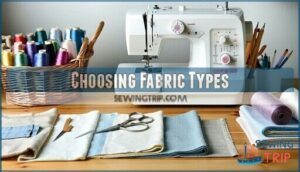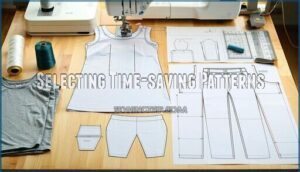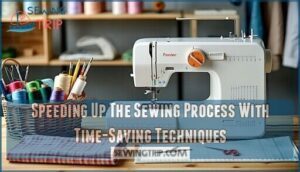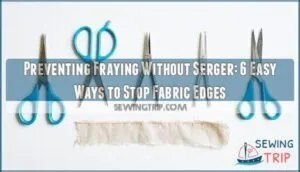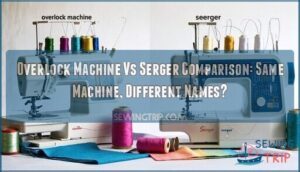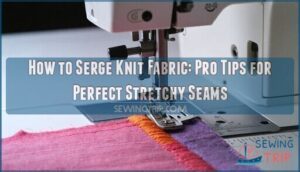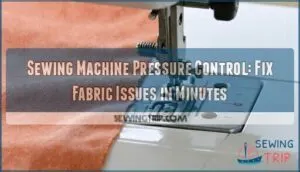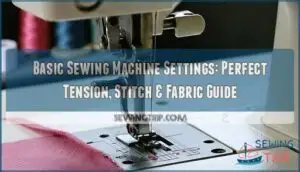This site is supported by our readers. We may earn a commission, at no cost to you, if you purchase through links.
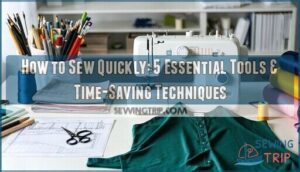 You’ll master how to sew quickly by combining the right tools with smart techniques. Start with specialized presser feet like ruffler attachments and blind hem feet that automate tedious tasks.
You’ll master how to sew quickly by combining the right tools with smart techniques. Start with specialized presser feet like ruffler attachments and blind hem feet that automate tedious tasks.
Organize your workspace with everything within arm’s reach—scissors, pins, and thread in designated spots. Choose forgiving fabrics like jersey knits that don’t fray easily, and select patterns with minimal pieces and simple construction.
Use batch processing: cut multiple projects at once, chain-piece seams without lifting your presser foot, and press seams in batches. These methods aren’t about rushing—they’re about working efficiently while maintaining quality results.
Professional seamstresses rely on these exact strategies to transform hours of work into minutes.
Table Of Contents
- Key Takeaways
- Top 5 Sewing Tools for Quick and Efficient Sewing
- Organizing Your Sewing Space for Speed and Efficiency
- Choosing Fabrics, Patterns, and Styles for Faster Sewing
- Speeding Up The Sewing Process With Time-Saving Techniques
- Essential Sewing Techniques for Quick and Professional Results
- Frequently Asked Questions (FAQs)
- Conclusion
Key Takeaways
- Invest in specialized presser feet – You’ll cut sewing time dramatically with tools like blind hem feet, ruffler attachments, and snap-on presser feet that automate tedious tasks and create professional results instantly.
- Organize your workspace strategically – Keep all tools within arm’s reach, position your machine and pressing station close together, and use clear storage containers so you’re not wasting time searching for supplies.
- Choose beginner-friendly fabrics and simple patterns – You’ll work faster with medium-weight cottons that don’t fray easily and patterns with fewer pieces, avoiding complex details like collars or intricate closures.
- Use batch processing techniques – You’ll maximize efficiency by chain-stitching multiple pieces without cutting threads, cutting all fabric at once, and completing similar tasks in groups rather than switching between different steps constantly.
Top 5 Sewing Tools for Quick and Efficient Sewing
The right tools can transform your sewing from a time-consuming hobby into an efficient craft that produces professional results in half the time.
These five essential tools streamline every step of your sewing process, from cutting fabric to finishing seams, so you can complete more projects without sacrificing quality.
1. Hem Foot Blind Sewing Machine Part
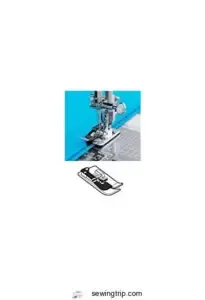
Mastering blind hemming transforms your sewing speed dramatically.
This specialized presser foot creates invisible hems on curtains, pants, and skirts while you maintain perfect fabric guide alignment.
Perfect fabric alignment creates flawless hems every time—no hand-stitching required.
You’ll achieve professional hemming techniques without hand-stitching, slashing project time substantially.
Troubleshooting hems becomes effortless with proper foot adjustment, making fast sewing methods accessible for every skill level, and allowing for dramatic improvements in efficiency.
2. Low Shank Snap on Sewing Machine Presser Foot
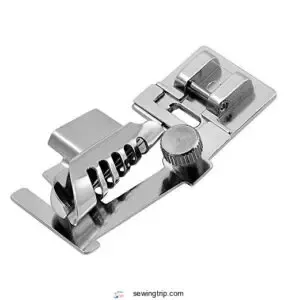
While hem feet handle basic hemming, snap-on presser feet release your machine’s full potential for sewing faster.
These interchangeable attachments transform how you tackle different techniques.
With snap-on advantages, you’ll switch between presser foot types in seconds rather than minutes of manual adjustments.
Understanding your shank height guide is key—most home machines use low shank compatibility.
Universal compatibility means one foot collection works across multiple projects.
You can adjust foot pressure for different fabric weights without wrestling with screws.
These sewing machine presser feet boost sewing machine efficiency dramatically.
Instead of fighting fabric through basic feet, specialized attachments guide materials precisely.
Your sewing machine techniques improve immediately when you match the right foot to each task.
Smart sewers know that proper presser foot selection makes the difference between struggling and flowing through projects.
With the right presser foot selection, you can ensure a smoother sewing experience, and sewing machine efficiency is greatly improved, allowing for faster sewing and more precise results.
3. HONEYSEW Ruffler Foot – Low Shank
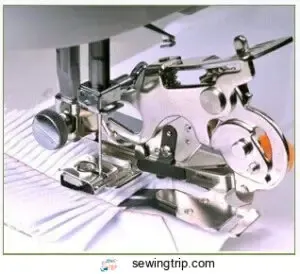
Your ruffler foot is about to become your secret weapon for lightning-fast fabric gathering. This Low Shank powerhouse transforms time-consuming pleating tasks into effortless operations, boosting your sewing efficiency dramatically.
Compatible with Singer, Brother, and Juki machines, the HONEYSEW Ruffler Foot delivers precise control over your gathering technique. You’ll create consistent, professional pleats in seconds rather than minutes of tedious hand-gathering.
The adjustable mechanism lets you customize pleat spacing and depth, giving you complete creative control. While there’s a slight learning curve initially, you’ll quickly master this game-changing sewing machine feet.
It handles everything from delicate tulle to medium-weight cottons with ease. Your sewing speed increases substantially once you’ve dialed in the perfect settings for your project.
This ruffler foot excels at single-layer fabric gathering, making it perfect for curtains, skirts, and decorative elements. Skip the frustration of uneven hand-gathering and embrace consistent, professional results.
Your sewing machine productivity will skyrocket as you tackle previously time-intensive projects with newfound confidence and sewing machine efficiency.
4. Clear Fabric Fusion Adhesive 4oz
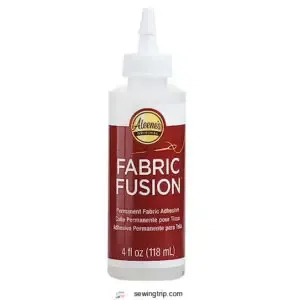
Clear Fabric Fusion Adhesive transforms your sewing workflow by eliminating tedious hand-stitching for embellishments and quick fixes.
This water-based adhesive creates permanent, flexible bonds that survive machine washing while maintaining fabric drape. You’ll love how it streamlines fabric bonding for appliqués, trims, and temporary holds during construction.
The clear formula disappears completely, making it perfect for delicate fabrics where visible stitching would compromise the design.
Key sewing shortcuts this adhesive enables:
- Instantly attach ribbons and lace without precise stitching lines
- Secure fabric patches for quick repairs before permanent sewing
- Hold seam allowances in place during complex curved seam construction
- Bond interfacing edges that tend to lift during pressing
For sewing efficiency, keep a small squeeze bottle at your workspace for instant fabric repair and quick positioning tasks that would otherwise slow your momentum.
Understanding the best fabric glue options is essential for achieving professional-looking results and ensuring the longevity of your sewing projects.
5. Serrated JulArt Pinking Shears Set
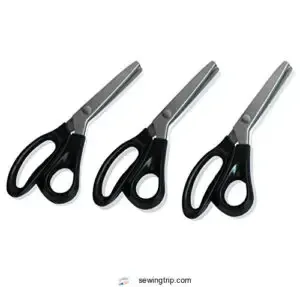
While fabric fusion adhesive works great for quick attachments, you’ll also need reliable cutting tools for finishing edges professionally. The Serrated JulArt Pinking Shears Set delivers that precision with three different sized shears crafted from durable stainless steel.
These pinking shears create distinctive zigzag cuts that prevent fabric fraying—a real timesaver when you’re working through multiple projects. You won’t need to serge or hem every raw edge, which speeds up your sewing process considerably.
| Feature | Small Shears | Medium Shears | Large Shears |
|---|---|---|---|
| Length | 6.5 inches | 8 inches | 9.2 inches |
| Best For | Detail work | General cutting | Heavy fabrics |
| Grip Size | Compact | Standard | Extended |
| Edge Type | Fine zigzag | Medium zigzag | Bold zigzag |
| Material | Stainless steel | Stainless steel | Stainless steel |
The comfortable grips reduce hand fatigue during extended cutting sessions, and the serrated edges stay sharp longer than standard fabric scissors. This feature, combined with the precision of the shears, makes them a valuable tool for any sewing project, allowing for professional finishing of edges and efficient workflow.
Organizing Your Sewing Space for Speed and Efficiency
Organization transforms chaos into productivity. Your sewing space becomes a command center when every tool has its place and every process flows smoothly.
Strategic Workspace Optimization starts with positioning your sewing machine, serger, and pressing station within arm’s reach. You’ll eliminate wasted steps and maintain momentum throughout your projects. A rolling swivel chair lets you glide between stations effortlessly.
Essential elements for an Efficient Layout include:
- Sewing Station setup with machines positioned close together for seamless shifts
- Tool Organization using drawer dividers, magnetic strips, and pegboards for instant access
- Storage Solutions like clear containers and labeled bins keeping supplies visible and sorted
- Lighting optimization with adjustable task lights eliminating shadows and reducing eye strain.
Smart sewing organization means grouping similar tasks together. Keep thread, bobbins, and notions organized by color or project type. Position a small trash bin under your table for quick cleanup of fabric scraps and thread tails.
Effective sewing room organization is vital for maximizing productivity and efficiency. Your workspace optimization directly impacts your sewing speed and enjoyment. When everything’s within reach, you’ll spend more time creating and less time searching.
Choosing Fabrics, Patterns, and Styles for Faster Sewing
Smart fabric and pattern choices can dramatically cut your sewing time in half.
You’ll spend less time wrestling with difficult materials and complex construction when you pick beginner-friendly options that work with your skills, not against them, which can help you achieve a more efficient sewing process with less time.
Choosing Fabric Types
Medium-weight cotton and linen reign supreme for sewing quickly. These fabric choices offer stability without bulk, making seam alignment effortless.
Cotton Choices like poplin and chambray provide firm weaves that resist fraying, while linen’s natural grip reduces pinning time.
Avoid slippery synthetics that’ll slow you down – stick with Fiber Blends under 250 gsm for ideal fabric preparation and organization.
For beginners, choosing the right fabric is vital, and understanding easy fabric options can make a substantial difference in the sewing process.
Selecting Time-saving Patterns
Smart pattern selection can cut your sewing time in half. You’ll want Simple Patterns with fewer pieces and minimal construction details. Quick Cuts mean choosing designs without fussy elements like collars or complex closures.
Focus on these Easy Designs for Speedy Sewing:
- Pull-on styles with elastic waistbands skip time-consuming zippers and buttons
- Loose-fitting garments require less fitting and adjustment during construction
- Flat construction methods let you sew pieces before joining into tubes
Time management improves dramatically when you pick sewing patterns designed for efficiency over elaborate details. For efficient sewing, consider using free sewing patterns to save time and fabric.
Optimal Sewing Styles
When speed matters most, choose loose-fitting designs with minimal construction details.
Skip collars, complex sleeves, and fussy closures that slow you down.
Flat construction methods and streamlined assembly techniques make garments come together faster.
Focus on simple necklines and straight seams – your fabric choice and efficient seams will create professional results without the headache.
Speeding Up The Sewing Process With Time-Saving Techniques
Several key strategies can accelerate your sewing workflow without sacrificing quality. These timesaving techniques focus on batch processing and streamlined workflow to boost your sewing productivity.
Here are five game-changing sewing hacks for speed and efficiency:
- Use fewer pins strategically – Space them out more, focusing only on seam beginnings and ends rather than every inch
- Chain stitch multiple pieces – Sew items consecutively without cutting threads between each piece
- Batch similar tasks – Complete step one on all items before moving to step two across your entire project
- Pre-wind bobbins – Keep several ready to avoid mid-project interruptions
- Employ pattern weights – Skip pinning patterns entirely and cut everything at once for efficient cutting
These methods transform your approach from start-and-stop to continuous motion. Fabric prep becomes faster when you’re not constantly switching between tasks. You’ll find yourself sewing faster as muscle memory develops through repetitive batch processing motions. Mastering sewing efficiency tips is essential to achieving a seamless and productive sewing experience.
Essential Sewing Techniques for Quick and Professional Results
Master these techniques to transform your sewing speed without sacrificing quality.
Chain stitching lets you sew multiple pieces consecutively without cutting threads between seams—think of it as your sewing assembly line.
This technique alone can cut your project time in half.
Flat construction changes everything.
Instead of wrestling with bulky, partially-assembled garments, sew sleeves before closing side seams.
Your fabric stays manageable, and you’ll wonder why you ever did it differently.
Smart sewing order matters more than you’d think.
Group similar tasks together—cut all pieces first, then do all your straight seams, followed by curves.
This rhythm keeps you in the zone and prevents constant machine adjustments.
Fabric prep saves headaches later.
Pre-wash everything and iron before cutting.
Your seams will lie flat, and you won’t face shrinkage surprises.
Thread management streamlines workflow.
Use gray thread for interior seams—it blends with most fabrics except pure black or white.
Keep pre-wound bobbins in basic colors ready, and you’ll spend less time switching threads and more time creating.
Understanding the correct sewing machine foot is essential for achieving professional results in your sewing projects.
Frequently Asked Questions (FAQs)
What is the fastest way to sew?
Pre-plan your sewing setup strategically.
Use chain stitching, flat construction methods, and minimize thread changes.
Skip unnecessary pins, batch similar tasks together, and choose simple patterns with fewer pieces for maximum efficiency.
How quickly can I learn to sew?
Like learning to ride a bike, you’ll wobble at first but find your rhythm faster than expected.
With daily practice, you’ll master basic stitches in 2-3 weeks and create simple projects within a month or two.
Is sewing a skill or talent?
Sewing’s definitely a skill you can develop through practice and patience.
While some folks have natural hand-eye coordination that gives them a head start, anyone can learn to sew well with dedication and consistent effort.
How do you prevent fabric from shifting while cutting?
Anchor your fabric like a ship dropping anchor—use pattern weights or a cutting mat’s grip.
Pin strategically at corners and curves, then cut with confident, smooth strokes to prevent shifting.
Whats the fastest way to thread a serger?
Thread your serger by following the threading guide diagram on your machine.
Start with the upper looper, then lower looper, right needle, and left needle.
Use tweezers to guide threads through tight spots easily.
How can you speed up buttonhole creation?
Use a buttonhole foot with built-in measurements and automatic sizing.
Mark all buttonhole positions first, then sew them consecutively without changing thread.
Practice consistent pressure and speed to maintain uniform stitch quality across all buttonholes.
Which seam finishes work best for speed?
Need speed without sacrificing durability?
Serging seams simultaneously finishes edges while joining fabric pieces, making it your fastest option.
Pinking shears quickly finish non-fraying fabrics, while flat-fell seams work great for cottons you can finger-press.
How do you quickly fix sewing mistakes?
Mistakes happen—don’t panic! For minor errors, simply backstitch over the problem area or use a seam ripper for clean removal. Quick fixes like fabric glue work for small tears.
Conclusion
Like a well-oiled machine humming through fabric layers, you’ve now got the blueprint for lightning-fast sewing.
These tools and techniques aren’t just shortcuts—they’re your pathway to professional-level efficiency.
When you learn how to sew quickly using specialized presser feet, organized workspaces, and batch processing methods, you’ll transform tedious hours into productive minutes.
Remember, speed comes from smart preparation, not rushed execution.
Your sewing machine will thank you, and so will your schedule.

